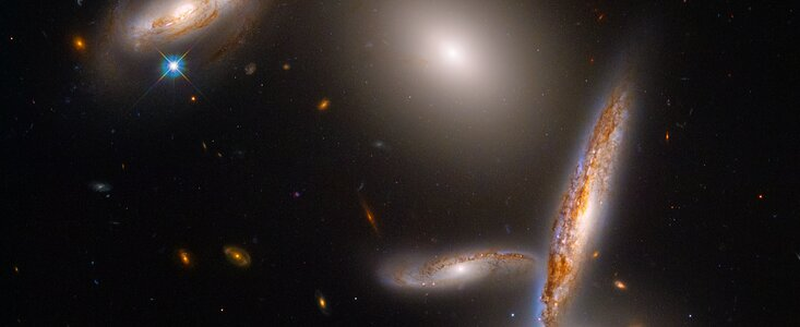The NASA/ESA Hubble Space Telescope is celebrating its 32nd birthday with a magnificent view of the Hickson Compact Group 40, an extraordinary close-knit grouping of five galaxies. This photo captures a special moment in their lives as they collide before merging.
The group has three spiral galaxies, an elliptical galaxy, and a lenticular (lens-like) galaxy. They are caught in a slow gravitational dance and are so dense that they may fit within an area of space less than twice the width of our Milky Way’s stellar disc.
Though such galaxy clusters can be found at the center of massive galaxy clusters, these galaxies are notable for being isolated in their own small area of the Universe, in the direction of the constellation Hydra.
One theory is that these galaxies are surrounded by a lot of dark matter (a poorly known and unseen kind of substance). If they get close enough, the dark matter can create a large cloud around which the galaxies orbit.
As the galaxies pass through the dark matter, they feel a frictional force caused by the gravitational effects of the dark matter.
This slows their speed and causes the galaxies to lose energy, causing them to collide. As a result, this photo captures the galaxies at a particularly special point in their lives. They will eventually collide and combine to form a single giant elliptical galaxy in around 1 billion years.

This galaxy group has been studied not only in visible light, but also in radio, infrared, and X-ray wavelengths. Almost all the galaxies have a compact radio emission at their center, which could indicate the presence of a supermassive black hole.
X-ray observations reveal that the galaxies have been gravitationally interacting, as evidenced by the presence of a large amount of hot gas among them. Infrared measurements provide information on the rate at which new stars develop.
Despite the fact that over 100 such compact galaxy groups have been identified in sky surveys dating back decades, Hickson Compact Group 40 is one of the most tightly packed. According to observations, such compact groupings were more prevalent in the early Universe and provided fuel for powering black holes known as quasars, whose light from superheated expanding material blazed across space.
Studying the features of galaxies in neighboring clusters like this helps astronomers figure out when and where galaxies form, as well as what they form from.





